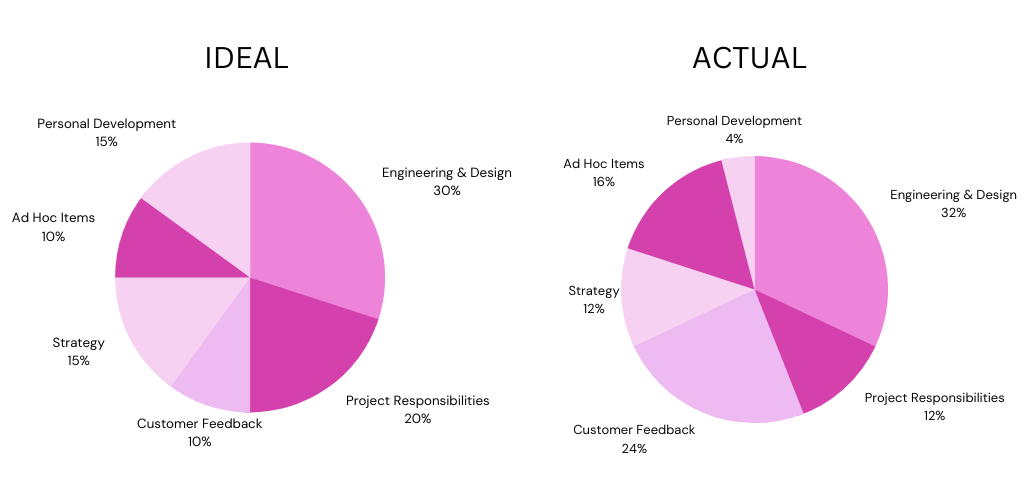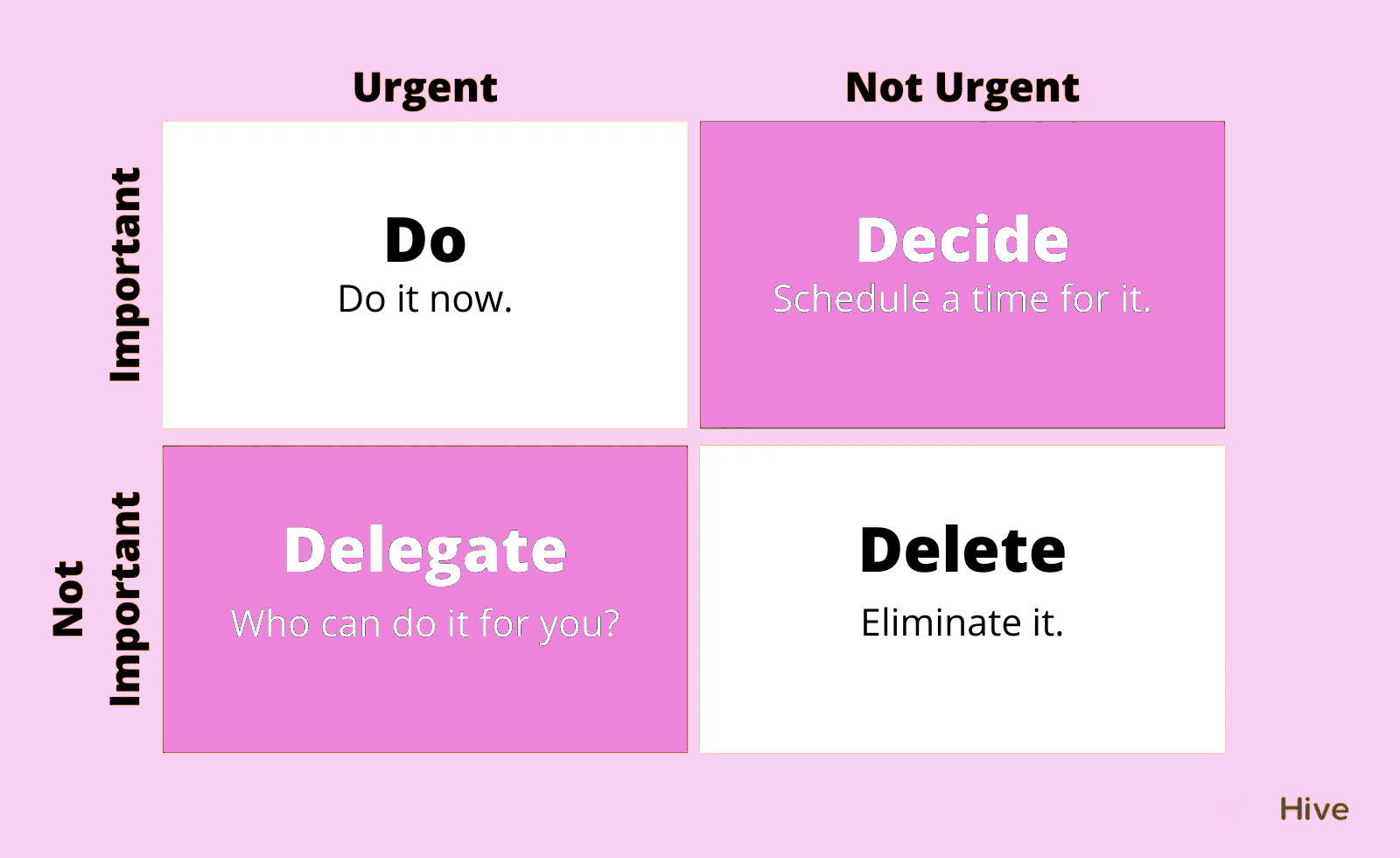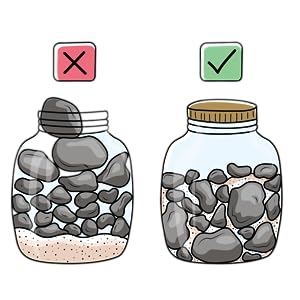
In the world of product management, drawing a distinction between prioritizing your personal responsibilities and prioritizing the specific tasks on your plate is extremely important. Think of it as operating under two distinct umbrellas. On one side, you have the actual work: the tasks, projects, and immediate deliverables that require attention. These are tangible items that can often be mapped out, scheduled, and checked off a list.
On the other side, there's the prioritization of oneself. This entails managing one's time, ensuring self-care, continuous learning, and professional growth. It's about setting boundaries, knowing when to delegate, and understanding your own strengths and limitations. Balancing these two aspects – the workload and personal management – is an art every product manager must master.
How do you spend your time
Learning how to spend your time and where it should be spent can be a challenge. Effectively allocating time is a nuanced task for anyone in product management. The emphasis of where to spend your time can shift depending on the current phase of your product's lifecycle. For instance, the exploratory phase may require extensive customer research, whereas the iterative phase demands more of a focus on strategy, design, and development.
However, irrespective of the phase, it's important to always start with your goal and then prioritize how you chose to spend your time. Consider the following areas:
- Customer Research: Meeting with customers, watching user sessions, talking with the support teams, listening to customer service recordings, reading customer service e-mails.
- Analyzing metrics: Evaluating KPI's, Success Metrics, looking at usage data.
- Re-evaluating Goals: Do your short, medium, and long-term goals need to be adjusted? What are you missing? Do you need to adjust metrics?
- Development: Ideation sessions, ceremonies, feedback from engineers and vice versa
- Design: Discuss latest design trends, UI/UX updates, future updates etc.
- Project Responsibilities: Prioritize backlog, write tickets, support, or Knowledge articles, OKR's, evaluate/re-evaluate commitments, deadlines, project management.
- Strategy: Work on the vision, mission, and goals. Adjust if needed. Plan the roadmap and adjust as needed. Explore new ideas and strategies.
- Recruiting: Interview and source candidates.
- Personal Development: Reading books, blog post, taking leadership courses, pm courses, or software courses.
- Managing/Leading/Mentoring: 1:1's and leading workshops
- Important Meetings: All hands, product team meetings, leadership meetings.
- Adhoc meetings: Being available and responsive when team members need you, removing impediments and unblocking your teammates, being helpful.
Keep in mind, the categories and how you allocate your time will evolve over time. This is perfectly normal. Everyone has their own way of categorizing tasks. Once you've chosen your categories, sketch out a pie chart of your ideal week. At week's end, chart out how you actually spent your time and contrast the two. Check out the charts below for reference.
Charts

🚨 Important: The ideal vs actual pie charts will often be more than 100% which proves that you can't do it all. This is where acceptance is important. By embracing acceptance and flexibility, you can set expectations that align with what's truly attainable.
Set dates for tasks that are important, but not urgent
If an assignment or task is due tomorrow, then it's easy to get done. That's simple. But beyond the obvious tasks that are immediate, there are many tasks that come up. I'm referring to bugs or new features that that are 'nice to haves.' You can work on these, but there will need to be a set time limit.
Working too long on something that would delight the user, can have consequences if there are other items that are more important and urgent. As a PM you will need to be able to identify what's more important and set time constraints for what tasks are nice to have's vs your must haves.
A helpful approach might be to ask your engineers, 'What's the maximum time we should spend on this, and what's the trade-off for the user if we shift our focus?'"
🚨 Important: Do your best to avoid making important decisions in silo's. Always include engineers in your decision making.
Eisenhower Priority Matrix
Whether you are trying to organize your day or prioritize your tasks and responsibilities, the Eisenhower Priority Matrix, also known as the Urgent-Important Matrix, is a time management tool that helps individuals prioritize tasks based on their importance and urgency.
"I have two kinds of problems, the urgent and the important. The urgent are not important, and the important are never urgent."- Dwight Eisenhower
While the matrix is versatile enough to be applied in various contexts, its nature aligns more effectively with personal task management than prioritizing product development features. Here are a few list of the benefits:
- Simplicity & Quick Decision-Making: The Eisenhower Matrix simplifies tasks into four clear categories based on urgency and importance. Compared to complex scoring systems or ranking methods, this allows Product Managers to quickly categorize and decide on actions for their tasks.
- Holistic Task View: Unlike many methods that prioritize based solely on business impact, the matrix enables Product Managers to look at both the urgency and importance of their tasks. This ensures that they don't neglect critical personal responsibilities or growth opportunities.
- Effective Time Allocation: With clear quadrants denoting what's urgent and what's important, Product Managers can schedule their day effectively, focusing on immediate concerns while still carving out time for long-term or strategic tasks.
- Avoidance of Busywork: The matrix distinctly identifies tasks that might be urgent but not important, helping Product Managers to delegate or delay tasks that could otherwise consume their time without adding much value.
- Clarity in Delegation: By singling out tasks that are urgent but perhaps not crucial for the Product Manager personally to handle, the matrix provides a natural guideline for delegation.
- Consistent Self-Reflection: The matrix isn't just a one-time tool. Regularly sorting tasks this way fosters self-awareness and reflection about where time is spent, promoting ongoing personal productivity improvements.
- Flexibility: While other methods might require a deep dive into task details, dependencies, or intricate scoring, the Eisenhower Matrix can be used flexibly, based on the Product Manager's intuition and knowledge of their tasks.
- Easily Adaptable: Given its simplicity, it can easily be merged with other productivity tools or digital platforms, ensuring that even in a tech-driven environment, the core principles of the matrix remain applicable.
The matrix is divided into four quadrants:

Quadrant I: Urgent and Important (Do First)
- These are tasks that require immediate attention and also align with your long-term goals or values.
Quadrant II: Not Urgent but Important (Schedule/Decide)
- These are tasks that don't have an immediate deadline, but are essential for long-term success and personal growth. Investing time in these tasks can reduce the occurrence of Quadrant I tasks. Examples: planning, roadmapping, relationship building, and personal development.
Quadrant III: Urgent but Not Important (Delegate)
- These tasks require immediate attention but don't necessarily help achieve long-term goals. If possible, these tasks can often be delegated to others. Examples: some meetings, some emails or phone calls, and some interruptions that can be managed by someone else.
Quadrant IV: Not Urgent and Not Important (Eliminate/Delete)
- These are tasks that don't align with your goals and don't require immediate attention. These are the tasks you say 'no' to. If this task has been assigned to you make sure you communicate and have a discussion before you silently dismiss it.
The Eisenhower Priority Matrix, when employed for personal task management, provides Product Managers with a structured, clear, and efficient approach to handling their diverse responsibilities, ensuring they remain focused, productive, and balanced. By classifying tasks using the Eisenhower Priority Matrix, you can better focus on what truly matters, delegate where possible, and reduce or eliminate tasks that don't add value to your goals.
Prioritizing for Efficiency
Big Rocks vs. Small Rocks
The analogy of "big rocks vs. small rocks" is a powerful visualization for understanding the concept of prioritization and effective time management. This analogy often involves a demonstration where an individual is tasked with fitting big rocks and pebbles into a jar. If one starts with pebbles, there's no room for the big rocks. But, if the big rocks are placed first, the pebbles can be added afterward, filling the spaces in between.

Big Rocks for a PM represent the pivotal tasks and strategic initiatives that have the most significant impact on the product's success and the company's overarching objectives. This might include defining the product vision, setting the roadmap, or launching a critical new feature.
Small Rocks, are the more routine or operational tasks that, while necessary, might not significantly steer the product's direction. Examples could be replying to non-urgent emails, minor bug fixes, or regular status meetings.
For a Product Manager (PM), the world is often inundated with a barrage of tasks ranging from defining product strategy, addressing customer feedback, coordinating with development teams, to managing stakeholders' expectations. It's about ensuring that amidst the whirlwind of demands and requests, the product's core objectives and deliverables are never sidelined.
The analogy of "big rocks vs. small rocks" serves as an invaluable tool in guiding PMs to prioritize their responsibilities effectively. By focusing on the big tasks first (the big rocks), you ensure that your most critical objectives and responsibilities are met. Once those are in place, you can then fit in the smaller tasks (small rocks).
💁♀️ Tip: Try proactively blocking off your calendar at the start of the week to focus on the most important task and work. Bigger tasks first then smaller task.
How to Prioritize different channels to be responsive
Creating rules and prioritizing channels in your inbox can help with answering most urgent request first so that you are available and more responsive to your teammates.
💁♀️ Tip: For various platforms like emails, messaging, project management, and documentation, you can set rules to funnel emails straight to your inbox. My mailbox is sorted by priority: leaders, teammates, project management tools (like Azure), and documentation platforms (like Confluence). After checking Teams in the morning, I then navigate through my inbox in this order: boss, leaders, colleagues, teams, Azure DevOps, followed by Confluence.
Additionally, discussing with your teammates about your preferred communication method can be advantageous. While you might have a set way of prioritizing tasks, their expectations might differ. Communication alignment is key! A well-thought-out prioritization won't yield optimal results unless it's in sync with what works best for your teammates too.
Final Words 📖
Execution goes beyond prioritizing features. To execute effectively, you must first prioritize yourself through time and task management. Without personal organization, even the best prioritization frameworks like Kano, RICE, or MoSCoW will fall short.
Start by evaluating the way you spend your time. Create a chart estimating time spent versus actual time spent on tasks. This will reveal opportunities to boost productivity and efficiency. Next, prioritize tasks using the Eisenhower Matrix to distinguish urgent/important work from less vital tasks. Apply the "big rocks vs. small rocks" principle by tackling urgent priorities first.
Make responding to key stakeholders a top priority. Focus communication on timely outreach to decision-makers and people vital for project success.
In summary:
- Effective execution requires personal organization
- Audit your time usage and adjust habits accordingly
- Prioritize tasks using the Eisenhower Matrix
- Tackle urgent/important "big rock" tasks first
- Make timely stakeholder communication a priority
Next Steps 🚀
- How to prioritize effectively as a new or aspiring Product Manager
- How to prioritize when everything feels important
- What are your Big Rocks